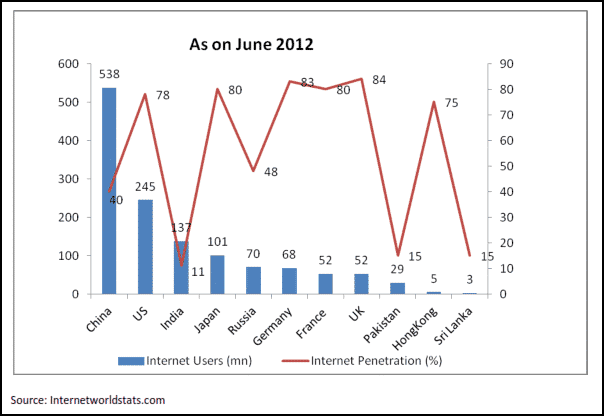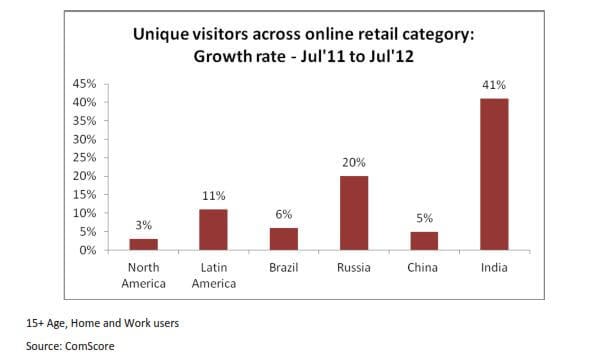The report provides the latest trends and developments in E-commerce in India for the years 2014-2015.
E-COMMERCE MARKET IN INDIA – REPORT
E-Commerce is gaining momentum globally with Asian economies like China, India and Indonesia being the fastest growing e-commerce markets. E-commerce in India is growing at a fast pace with an estimated size of Rs.43,930 crore in FY13 and a CAGR of 43.8% (FY08-13). As per the internetworldstats.com – The top 20 countries in the internet by the number of users as on June 30, 2012, India ranks 3rd after China and the US. The eCommerce industry is mainly dominated by the travel segment which accounts for more than 70% of the transactions of industry and e-retail’s share in e-commerce stands at approximately 12.5%. In spite of the robust growth, the e-commerce industry is still in a nascent stage with significant e-commerce ventures being started by young first-time entrepreneurs. The e-commerce industry in India lags far behind various developed and developing countries (share of e-commerce to total retail is approximately 1.5% vis-à-vis 5.8% in US) mainly on account of low internet penetration due to poor infrastructure.
E-COMMERCE IN INDIA: EVOLVING MODELS
The Indian e-commerce industry comprises two key business models: B2B (90% of market share) and the remaining 10% comprise of B2C. India and China, unlike the US are characterized by the ‘Marketplace Model’, while the US follows an inventory-based/independent model. ‘Market Place’ model only provides a platform to a large number of manufacturers/traders (especially MSMEs) to advertise their products (which translates to benefit the MSMEs in the form of increased turnover) as well as manages related functions and in turn, the entity earns commission from sellers for goods and services. The B2B players do not carry inventory while in the other model-B2C, the merchant owns the goods. Currently, FDI is restricted in the B2C model in India.
E-RETAILING: AT AN INFLEXION POINT
The e-retailing market in India is estimated at Rs.5,513 crore in FY13 with a robust CAGR of 30.5% (FY08-FY13). Below-average penetration of e-retailing has led to the explosive growth of unique visitors from July 2011 to July 2012 within the Indian retail online market.
Key Drivers for E-Retailing
Today’s consumers, especially middle-class urban and semi-urban India, who are increasingly pressurized due to paucity of time as well as lured by convenience and increased use of plastic money is all leading way to more online consumption. Furthermore, favorable demographic profiles (75% of internet users are aged between 15-34), limited geographical reach by brick & mortar model, increasing internet penetration, increasing smartphone usage & declining data charges offer the high market potential for e-retailing in India.
Indian Ecommerce: Growing under constraints
The inability to provide a direct connection with the consumer is the biggest challenge in e-retailing. Further, apart from low internet penetration, like low debit card/credit card usage which is being offset by cash on delivery, multiple languages, and logistics issues which is being managed by building in-house logistics by players are also some of the challenges faced by players. However with the help of technology, the backbone of e-retailing, an attempt is made to bridge this gap. Also, other challenges are developing efficient supply chain management, customer relationship management solution and enhanced security systems which form the heart of e-retailing. Foreign capital inflow is the next logical step to build the necessary infrastructure.
FDI in B2C: Next Logical Step
FDI in e-Commerce in India has seen around US$1.3 billion of foreign investment in the eCommerce industry from 2010 to June 2013 and a large number of deals compared with some other peers on account of the huge potential seen in India.
At present, 100% FDI is allowed in business-to-business (B2B) e-commerce. Restriction on FDI in B2CInventory / Independent model has restricted the growth of this segment on account of the lack of financial backing required for their expansion plans. Equity funding is important for the growth of e-retailing given the large requirements on account of deep discounts given to the customer as an acquisition strategy, for establishing logistics and creating differentiation in terms of customer service.
FDI in B2C: Pros and Cons
FDI in the B2C model is likely to have a positive impact on overall economic development. It will provide the required significant financial backing to the young entrepreneurs. MSMEs, if provided financial backing, will be able to enhance their coverage through e-commerce platforms. The long-term committed investment will also bring in know-how and improve efficiencies in the supply chain necessary for the industry and also lead to competitive pricing. It will boost ancillary industries like logistics, warehousing, online advertising, etc. Minimum investment requirements, if mandated, in backend may also lead to infrastructure development. On the other hand, with the opening of FDI in the B2C model, monopolies of foreign retailers may adversely impact the domestic industry Brick and Mortar players as well as existing B2C players leading to consolidation in the industry. It may shrink the Indian Entrepreneurship & MSME sector. However, a foreign player’s entry with certain riders like mandated minimum local sourcing with the MSMEs will lead to increased manufacturing activities.
Conclusion
With the new government focusing on overall economic development, they may look at a carefully calibrated approach for opening up the B2C model in India to FDI. Opening up of Foreign Direct Investment (FDI) in this segment shall change the contours of the E-commerce industry in India as well as contribute positively to the overall economic development going forward.



